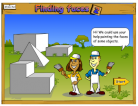Basic Concept
 Wana Daphne Lin Hsiao stated that basically, constructivism views that knowledge is not ‘about’ the world, but rather ‘constitutive’ of the world (Sherman, 1995). Constructivist approach to learning emphasizes authentic, challenging projects that include students, teachers and experts in the learning community. In an authentic environment, learners assume the responsibilities of their own learning, they have to develop metacognitive abilities to monitor and direct their own learning and performance. When people work collaboratively in an authentic activity, they bring their own framework and perspectives to the activity. The constructivist paradigm has led us to understand how learning can be facilitated through certain types of engaging, constructive activities. This model of learning emphasizes meaning-making through active participation in socially, culturally, historically, and politically situated contexts. Constructivists argue that it is impractical for teachers to make all the current decisions and dump the information to students without involving students in the decision process and assessing students’ abilities to construct knowledge. This student-centered guided learning environment is considered, however, more appropriate for ill-structured domains or higher-level learning (CTGV, 1991).
Wana Daphne Lin Hsiao stated that basically, constructivism views that knowledge is not ‘about’ the world, but rather ‘constitutive’ of the world (Sherman, 1995). Constructivist approach to learning emphasizes authentic, challenging projects that include students, teachers and experts in the learning community. In an authentic environment, learners assume the responsibilities of their own learning, they have to develop metacognitive abilities to monitor and direct their own learning and performance. When people work collaboratively in an authentic activity, they bring their own framework and perspectives to the activity. The constructivist paradigm has led us to understand how learning can be facilitated through certain types of engaging, constructive activities. This model of learning emphasizes meaning-making through active participation in socially, culturally, historically, and politically situated contexts. Constructivists argue that it is impractical for teachers to make all the current decisions and dump the information to students without involving students in the decision process and assessing students’ abilities to construct knowledge. This student-centered guided learning environment is considered, however, more appropriate for ill-structured domains or higher-level learning (CTGV, 1991).
C. Huitt explained more detailed that the constructivistic approach to teaching and learning is based on a combination of a subset of research within cognitive psychology and a subset of research within social psychology, just as behavior modification techniques are based on operant conditioning theory within behavioral psychology. The basic premise is that an individual learner must actively “build” knowledge and skills (e.g., Bruner, 1990) and that information exists within these built constructs rather than in the external environment. A major problem is that making connections between thinking (in terms of knowledge, intellectual skills, attitudes, etc.) and behavior has proven very illusive (Doyle, 1997). As Doyle points out
Mental representations such as attitudes, mental models, scripts, and schemas are, of course, related to behavior, but the relationship is often complex and counterintuitive. Fennimore and Tinzmann (1990) suggest a difference between a behaviorally-oriented curriculum in which knowledge and skills are taught discretely and then inductively connected versus the constructivistically-oriented classroom in which students acquire content while carrying out tasks requiring higher-order thinking:
An example should help clarify this characteristic of a thinking curriculum. Summarizing is a common skill learned in school. In conventional curricula, young students frequently are expected to learn how to summarize by first learning each “step” in the summarizing process. They are taught these steps one at a time. Then, the teacher may teach them a second “step;” for example, deleting redundant information. Again, the students practice. This approach continues until students have been taught all the steps or subprocesses thought to be involved in summarizing. In short, curriculum tends to routinize the task. Rather than fragmenting the process, it would be taught in a context or environment in which students can succeed. The teacher may also ask students to work collaboratively to summarize information at this initial learning stage. As students gain skill and confidence in summarizing, the teacher would ask them to summarize longer paragraphs, perhaps containing less familiar information. Instruction must be concerned with the experiences and contexts that make the student willing and able to learn (readiness).
Advocates of a constructivistic approach suggest that educators first consider the knowledge and experiences students bring with them to the learning task. The school curriculum should then be built so that students can expand and develop this knowledge and experience by connecting them to new learning. Advocates of the behavioral approach, on the other hand, advocate first deciding what knowledge or skills students should acquire and then developing curriculum that will provide for their development.
Those advocating a constructivisitic approach should consider there are a variety of principles from operant conditioning and information processing learning theories that can be utilized within this approach. For example, when mediating a student’s learning it is certainly appropriate to teach a specific skill using direct instruction, observe students practicing the skill, and providing corrective feedback. Principles of learning from an information processing perspective such as recognizing the limits of short-term memory, providing many opportunities for students to connect prior knowledge to current learning, and recognizing the need for spaced practice can also be implemented within a constructivistic approach. Again, the major distinction is in where to start: with a predesigned curriculum or with the student’s experiences and knowledge base.
If we start with the student’s knowledge base before we have established desired end goals, there is a tendency to have the students simply “make progress,” thereby limiting students who are not adequately prepared. These students may develop adequate thinking skills, but can have large gaps in their knowledge and skills.
Constructivism in the Classroom: an Example
Constructivist teachers pose questions and problems, then guide students to help them find their own answers. prompt students to formulate their own questions (inquiry) allow multiple interpretations and expressions of learning (multiple intelligences) encourage group work and the use of peers as resources (collaborative learning) For now, it’s important to realize that the constructivist approach borrows from many other practices in the pursuit of its primary goal: helping students learn HOW TO LEARN.
In a constructivist classroom, learning is . . . Students are not blank slates upon which knowledge is etched. They come to learning situations with already formulated knowledge, ideas, and understandings. Rather than starting the problem by introducing the ruler, the teacher allows students to reflect and to construct their own methods of measurement. One student offers the knowledge that a doctor said he is four feet tall.
The student is the person who creates new understanding for him/herself. The teacher coaches, moderates, suggests, but allows the students room to experiment, ask questions, try things that don’t work. Learning activities require the students’ full participation (like hands-on experiments). An important part of the learning process is that students reflect on, and talk about, their activities. Students also help set their own goals and means of assessment. The teacher provides opportunities for students to examine the finished and earlier drafts of various authors. He allows students to select and create projects within the general requirement of building a portfolio 1. In a history class, asking students to read and think about different versions of and perspectives on “history” can lead to interesting discussions. Is history as taught in textbooks accurate? From there, students can make their own judgments.
Students control their own learning process, and they lead the way by eflecting on their experiences. The teacher helps create situations where the students feel safe questioning and reflecting on their own processes, either privately or in group discussions. The teacher should also create activities that lead the student to reflect on his or her prior knowledge and experiences. Periodically the teacher reads these journals and holds a conference with the student where the two assess (1) what new knowledge the student has created, (2) how the student learns best, and (3) the learning environment and the teacher’s role in it. The constructivist classroom relies heavily on collaboration among students. When students review and reflect on their learning processes together, they can pick up strategies and methods from one another.
Example: In the course of studying ancient civilizations, students undertake an archaeological dig. As the students find different objects, the teacher introduces classifying techniques. As students explore the topic, they draw conclusions, and, as exploration continues, they revisit those onclusions. (See the CONCEPT TO CLASSROOM workshop Inquiry-based Learning) Depending upon students’ responses, the teacher encourages abstract as well as concrete, poetic as well as practical, creations of new knowledge.
What happens when a student gets a new piece of information? The new information matches up with his previous knowledge pretty well (it’s consonant with the previous knowledge), so the student adds it to his understanding. The information doesn’t match previous knowledge (it’s dissonant). The student has to change her previous understanding to find a fit for the information. Rejected bits of information may just not be absorbed by the student. Example: An elementary teacher believes her students are ready to study gravity. Students explore the differences in weight among similarly sized blocks of Styrofoam, wood, and lead. Some students hold the notion that heavier objects fall faster than light ones. The students then replicate Galileo’s experiment by dropping objects of different weights and measuring how fast they fall.
Sources:
- http://www.thirteen.org/edonline/concept2class/constructivism/index_sub2.html
- http://www.edb.utexas.edu/csclstudent/Dhsiao/theories.html#construc
- http://chiron.valdosta.edu/whuitt/col/cogsys/construct.html















